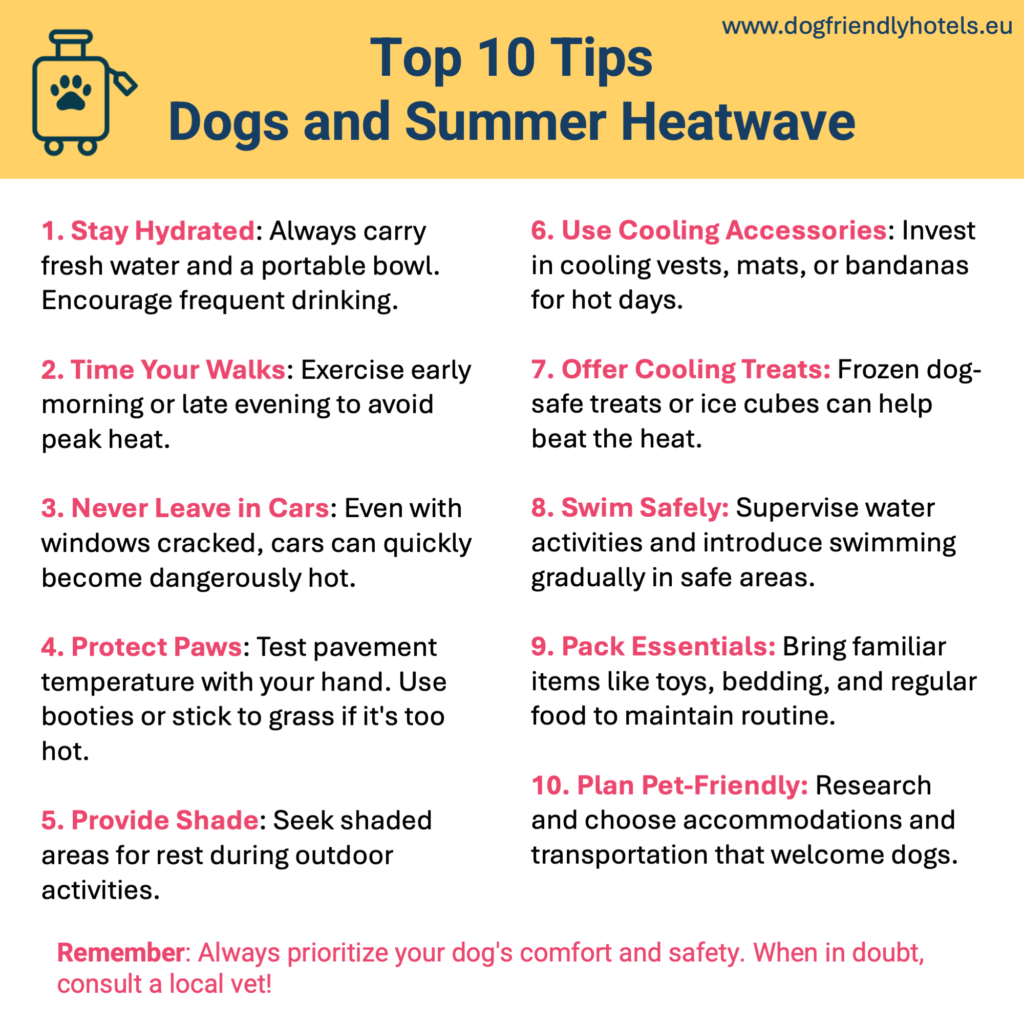Keeping Your Furry Friend Safe and Happy: A Guide to Summer Travel with Dogs in Europe
Friendly Disclaimer: This article is intended for informational purposes only and does not substitute professional veterinary advice. Always consult your veterinarian for personalized guidance on your dog’s health and well-being, especially when traveling or in hot weather conditions.
As summer approaches and vacation plans take shape, many dog owners are eager to include their four-legged companions in their European adventures. However, traveling with dogs during the hot summer months requires careful planning and consideration. This comprehensive guide will help you ensure your furry friend stays safe, comfortable, and happy while exploring Europe’s diverse landscapes and cultures.

Understanding the Risks of Summer Heat for Dogs
Before embarking on your European journey, it’s crucial to understand how summer heat can affect your dog. Unlike humans, dogs can’t regulate their body temperature through sweating. Instead, they rely on panting and releasing heat through their paw pads and nose. This makes them more susceptible to overheating and heatstroke, especially in unfamiliar environments.
Signs of Heatstroke in Dogs:
- Excessive panting
- Drooling
- Purple gums or red skin
- Vomiting or diarrhea
- Collapse
- Disorientation
If you notice any of these symptoms, immediately move your dog to a cool area, wet their coat with tepid water, and contact a local veterinarian. Remember, prevention is always better than treatment when it comes to heatstroke.
Planning Your European Dog-Friendly Vacation
1. Choose Dog-Friendly Destinations
Research and select locations in Europe that are known for their pet-friendly amenities. Countries like Germany, Italy, and France often have numerous parks, outdoor cafes, and accommodations that welcome dogs.
2. Travel During Cooler Months or Times
If possible, plan your trip during the shoulder season (late spring or early fall) when temperatures are milder. If summer travel is unavoidable, schedule outdoor activities for early mornings or evenings when it’s cooler.
3. Arrange Pet-Friendly Transportation
Whether you’re traveling by car, train, or plane, ensure your mode of transportation accommodates dogs. Many European train systems and airlines have specific pet policies, so check these in advance.
4. Pack Essential Supplies
Bring familiar items from home to help your dog feel comfortable:
- Collapsible water bowl and plenty of fresh water
- Regular food and treats
- Leash, harness, and collar with ID tags
- Favorite toys and bedding
- Cooling mat or vest for hot days
- Poop bags and cleaning supplies
5. Update Vaccinations and Health Certificates
Ensure your dog’s vaccinations are up-to-date and obtain any necessary health certificates required for international travel within Europe.
Keeping Your Dog Cool in European Summer Heat
1. Provide Constant Access to Water
Always carry a portable water bowl and fresh water. Encourage your dog to drink regularly, especially during outdoor activities.
2. Limit Exercise to Cooler Hours
In hot European cities, walk your dog early in the morning or late in the evening when temperatures are lower. Avoid strenuous exercise during midday heat.
3. Seek Shade and Cool Spots
When exploring European cities or beaches, look for shaded areas where your dog can rest and cool down.
4. Use Cooling Accessories
Invest in cooling products like bandanas, vests, or mats that can help regulate your dog’s body temperature during hot days.
5. Never Leave Your Dog in a Parked Car
Even with windows cracked, temperatures inside a car can quickly reach dangerous levels. Always take your dog with you or leave them in a cool, safe place.
6. Protect Paw Pads
European city streets can get extremely hot. Test the pavement with your hand – if it’s too hot for you, it’s too hot for your dog’s paws. Consider using booties or walking on grass when possible.
7. Offer Cooling Treats
Frozen dog-friendly treats or ice cubes can help keep your pup cool and hydrated.
Navigating European Beaches and Swimming Areas
Many European coastal destinations offer dog-friendly beaches, but it’s important to exercise caution:
1. Introduce Water Gradually
Not all dogs are natural swimmers. Use a shallow area to let your dog become comfortable with water at their own pace.
2. Supervise at All Times
Even if your dog is a strong swimmer, always keep a close eye on them in the water.
3. Rinse After Swimming
Salt water and chemicals from pools can irritate your dog’s skin. Rinse them off with fresh water after swimming.
4. Be Aware of Water Intoxication
Limit swimming sessions to prevent your dog from swallowing too much water, which can lead to water intoxication.
5. Check for Hazards
Before letting your dog swim, check for strong currents, blue-green algae, or other potential dangers.
Protecting Against European Summer Pests
1. Use Flea and Tick Prevention
Europe has its share of fleas and ticks. Ensure your dog is protected with appropriate preventatives.
2. Be Aware of Local Wildlife
Research the area you’re visiting for potential hazards like adders (venomous snakes found in some parts of Europe) or aggressive insects.
3. Watch for Signs of Insect Stings
If your dog shows signs of swelling or difficulty breathing after an insect encounter, seek veterinary care immediately.
Conclusion: Enjoying a Safe European Adventure with Your Dog
Traveling through Europe with your dog during summer can be a wonderful experience with proper planning and precautions. By staying vigilant about your dog’s comfort and health, you can create lasting memories while exploring the diverse landscapes and cultures of Europe. Remember to always prioritize your dog’s well-being, adapt your plans to accommodate their needs, and don’t hesitate to seek professional veterinary advice if you have any concerns during your journey.
With these tips in mind, you and your furry companion are ready to embark on an unforgettable European summer adventure. Bon voyage!
